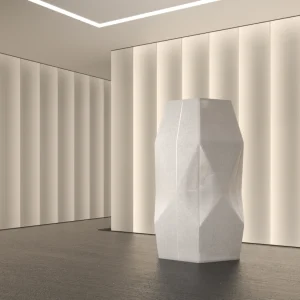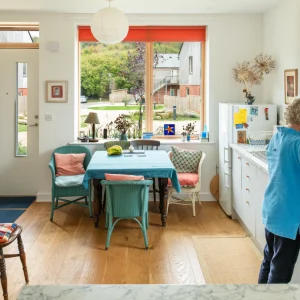The Furniture of Chandigarh in a cavernous underground space at P3, presents a series of 1950s furniture that were part of the buildings Le Corbusier with his cousin, Pierre Jeanneret, were responsible for designing. After Indian independence in 1947 and the subsequent partition of India and Pakistan, there was a need for a new administrative capital for the Indian Punjab. The two modernist heros were enlisted alongside other British and Indian architects to come up with a masterplan that considered everything from the smallest of detail of interiors and furniture to infrastructure and buildings. This revolutionary city was to signal the dawn of a new age by erasing the poverty-stricken slums that characterised the site before and realising a masterplan that promised to provide shelter and quality of life.
For this exhibition, considerable effort has been made to restore the dignity of the original 1950s furniture of Corbusier and Jeanneret, which were discarded but, thankfully, have been salvaged by the owners of the collection. Even greater though has been put into reenacting the social function of the furniture back when they were in their original setting, looking all pristine and serious. Perhaps the most interesting part of the exhibition is the layout of several bridge chairs, v-leg benches, a judges box, a readers table, and an accused cabin which recreate the atmosphere and austerity of a court room. Most of the furniture displayed is made of wood, a cheap local material that corresponds well, physically and socially, with the low-cost brick that defines the architecture of Chandigarh. Understandably, production of furniture was outsourced to local teams of craftsmen since the cost of labour was lower than mass production; a move by the design team that is reminiscent of the arts and crafts movement but without the heavily romanticised ideology. The functionality of most furniture was considered but not always paramount. For instance, although the accused cabin allows for decent security, it has an unforgettably idiosyncratic design, which leaves room for imagination and escape.
Although the highlight of the show is the furniture, also present are two films that unravel the social impact the city had on the people. Alain Tanner’s Une Ville A Chandigarh, filmed shortly after the completion of the city, was a gentle contemplation that weighed both the strengths and weaknesses of the project. As the film reveals, the atmosphere of the traditional bazaar is preserved but the hygiene and population of the market has been rationalised by the architecture of Corbusier and Jeanneret. However, change does not often come as quickly as one wishes. While Chandigarh pledged to end the miserable condition of living of the poor, the film exposes the fact that most of the labourers who built the city did not live in them at all. A sense of identity, sustained by countless years of habits, still dictates the way of living for the working class Indian. But before we begin condemning the architects’ utopian outlook, Tanner hints that the religious tradition of patience that underlines Indian culture could be the culprit here.
By contrast, another film, From A New Architecture speaks critically about Corbusier and his collaborators work. The city was revisited by the filmmakers, Ultrafunction, who one year ago found soldiers guarding the high court and a plastic tent placed between two column of a building in Chandigarh. The film is unreserved in pointing out the evils of concrete and its aesthetic disadvantages with the present state of affairs at the city.
Yet if we were to think Corbusier and his design team as merely creators, we will be shortchanged. Corbusier saw himself as spiritual director in the project and his capacity for turning dreams to reality is more important; this is what is manifested in every part of this exhibition.
The Furniture of Chandigarh – Le Corbusier and Pierre Jeanneret
20 June – 12 July 2009
Admission free
P3, London, UK
www.p3exhibitions.com








